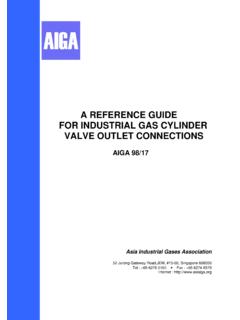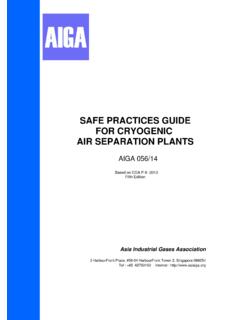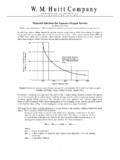Transcription of SAFE INSTALLATION AND OPERATION OF PSA AND …
1 safe INSTALLATION AND OPERATION OF PSA AND MEMBRANE oxygen AND NITROGEN GENERATORS AIGA 060/11 GLOBALLY HARMONISED DOCUMENT Based on CGA P 2010 Third Edition Asia Industrial Gases Association 3 HarbourFront Place, #09-04 HarbourFront Tower 2, Singapore 099254 Tel : +65 6276 0160 Fax : +65 6274 9379 Internet : Reproduced with permission from the Compressed Gas Association. All rights reserved ASIA INDUSTRIAL GASES ASSOCIATION 3 HarbourFront Place, #09-04 HarbourFront Tower 2, Singapore 099254 Tel: +65 62760160 Fax: +65 62749379 Internet: AIGA 060/11 GLOBALLY HARMONISED DOCUMENT safe INSTALLATION AND OPERATION OF PSA AND MEMBRANE oxygen AND NITROGEN GENERATORS Disclaimer All publications of AIGA or bearing AIGA s name contain information, including Codes of Practice, safety procedures and other technical information that were obtained from sources believed by AIGA to be reliable and/ or based on technical information and experience currently available from members of AIGA and others at the date of the publication.
2 As such, we do not make any representation or warranty nor accept any liability as to the accuracy, completeness or correctness of the information con-tained in these publications. While AIGA recommends that its members refer to or use its publications, such reference to or use thereof by its members or third parties is purely voluntary and not binding. AIGA or its members make no guarantee of the results and assume no liability or responsibility in connection with the reference to or use of information or suggestions contained in AIGA s publications. AIGA has no control whatsoever as regards, performance or non performance, misinterpretation, proper or improper use of any information or suggestions contained in AIGA s publications by any person or entity (including AIGA members) and AIGA ex-pressly disclaims any liability in connection thereto.
3 AIGA s publications are subject to periodic review and users are cautioned to obtain the latest edition AIGA 060/11 ii NOTE Technical changes from the previous edition are underlined. Contents 1 1 2 Scope and purpose .. 1 Scope .. 1 Purpose .. 1 3 1 Asphyxiation .. 1 Cryogenic liquid .. 1 2 Deoxo 2 Double block and bleed .. 2 Hot repairs .. 2 Locked out .. 2 Material safety data sheet (MSDS).. 2 Membrane .. 2 oxygen -deficient atmosphere/Nitrogen-enriched atmosphere .. 2 oxygen -enriched atmosphere .. 2 Pressure relief device (PRD) .. 2 Pressure swing adsorption (PSA).. 2 safe area.
4 2 Safety 3 Vacuum swing adsorption (VSA).. 3 4 Health hazards .. 3 3 Cryogenic liquid hazards .. 3 Nitrogen hazards .. 3 oxygen hazards .. 5 Protective clothing .. 5 5 General plant 6 Site selection .. 6 Materials of 7 Cleaning .. 7 Electrical requirements .. 7 Fire 7 Emergency shut-down system .. 8 Noise .. 8 Venting .. 8 Dusting .. 8 Fluid discharge/solid 9 Hazard 9 6 Compressors .. 9 9 Special consideration for the compression of oxygen .. 10 (AIGA publications are listed in the references)Special consideration for the compression of nitrogen .. 10 7 Product storage .. 10 10 Cryogenic liquid storage .. 10 High pressure gas storage.
5 10 8 Plant 11 11 Pressure relief devices .. 11 Pressure reducing stations .. 11 System isolation .. 11 AIGA 060/11 Aboveground piping .. 11 Underground piping .. 11 Insulation .. 11 9 operations .. 12 12 operations checklists/log sheets .. 12 Procedures .. 12 12 13 13 Auto restart .. 13 Maintenance .. 13 10 PSA/VSA oxygen generators .. 14 14 INSTALLATION .. 15 operations 16 11 PSA nitrogen generators .. 18 18 INSTALLATION .. 20 12 Membrane nitrogen generators .. 21 21 INSTALLATION .. 24 Operating hazards .. 24 13 oxygen removal (deoxo) systems for nitrogen systems.
6 24 24 INSTALLATION .. 26 operations 26 14 References .. 28 Table Table 1 Effects at various oxygen breathing levels .. 4 Figures Figure 1 PSA/VSA oxygen generator flow 15 Figure 2 Small oxygen 16 Figure 3 oxygen VSA .. 17 Figure 4 Three-bed oxygen PSA .. 17 Figure 5 oxygen PSA medical 18 Figure 6 PSA nitrogen generator flow diagram .. 19 Figure 7 Small nitrogen generator .. 20 Figure 8 Nitrogen generator .. 20 Figure 9 Membrane nitrogen flow diagram .. 22 Figure 10 Nitrogen 23 Figure 11 Small nitrogen membrane .. 23 Figure 12 Deoxo flow 25 Figure 13 Deoxo 26 AIGA 060/11 11 Introduction As a part of the programme of harmonization of industry standards, the Asia Industrial Gases Association (AIGA) has adopted the original Compressed Gas Association (CGA) standard This standard is in-tended as an international harmonized standard for the use and application by members of CGA, EIGA, JIMGA and AIGA.
7 This edition has the same content as the CGA edition except for editorial changes in formatting, units, spelling and references. References to and Canadian regulatory requirements are replaced by references to international, national and local requirements and additional references are also made to applicable AIGA s documents. oxygen and nitrogen generators that use pressure swing adsorption (PSA) and membrane technologies, like many present day processes, have some degree of potential hazards that must be recognized and ad-dressed. Common hazards associated with these generators are the asphyxiant properties of oxygen -deficient atmospheres and the ability of oxygen -enriched atmospheres to accelerate combustion.
8 Other hazards include noise, electricity, rotating equipment, and gases under pressure. oxygen and nitrogen generator technology is not static; it has progressed rapidly over the last 15 years and continues to do so. Because a wide variety of plant process cycles, equipment, and operating conditions are in use, this publication includes some generalized statements and recommendations with which there may be diversity of opinion or practice. Users of this guide should recognize that it is presented with the understanding that it cannot take the place of sound engineering judgment, training, and experience. It does not constitute, and should not be construed to be, a code of rules or regulations.
9 2 Scope and purpose Scope This publication is a guide that applies to safety in the location, INSTALLATION , OPERATION , and maintenance of certain oxygen and nitrogen generators. Included are systems using PSA and membranes for nitrogen pro-duction, PSA and vacuum swing adsorption (VSA) for oxygen production, and catalyst-based oxygen re-moval systems for nitrogen purification. For systems using cryogenic technologies for the production of nitrogen, oxygen , or both (see CGA P-8, safe Practices Guide for Air Separation Plants [1]).1 Emphasis has been placed on equipment and operational features that are peculiar to these system proc-esses. Limited coverage has been given to plant equipment such as air compressors used in other indus-trial applications and for which safe practices in design, INSTALLATION , and use have already been established elsewhere.
10 While important supplemental equipment such as in-plant transfer piping is included, liquid backup for pipelines and cylinder filling facilities that are an adjunct to some oxygen and nitrogen genera-tors are not covered. Also, coverage is not extended to equipment such as product transmission piping outside the generator boundaries. While many references have been cited in this guide that give information relating to air separation plants, related equipment, and their products, the reference section is not intended to be all inclusive. Not all +, state, provincial, or local requirements, regulations, and ordinances are listed. Further, as this publication is not intended as a universal safe practices manual for specific design and safety features, it is important to refer to the operating manuals of the equipment supplier.
















